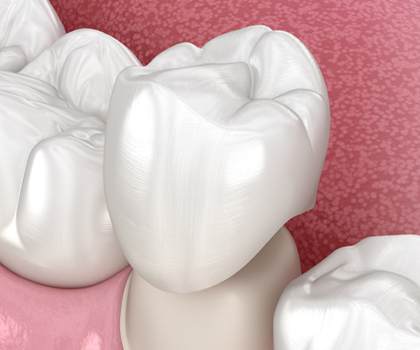Crowns
What is a crown?
Crowns are an ideal restoration for teeth, which have been broken, or have been weakened by decay or by placing a very large filling. Root treated teeth may require a crown to protect the remaining tooth.

How long will a crown last?
The life of a crown depends on how much pressure is applied on the bite and how well it is looked after. The crown cannot decay, but decay can start where the edge of crown joins the tooth. It is very important to keep the gums and crown clean. Eight to ten years would be an average life expectancy for a crown.
Precious metal crowns – Gold and palladium crowns are very strong and hard wearing and are usually used at the back of the mouth. They are not visible and most suitable for people who grind and clench their teeth.
What are crowns made of?
Crowns are made of a variety of materials including porcelain and gold. Different materials are used for different areas of the mouth.
Crowns or Veneers?
Depending on the health of your teeth Crowns and Veneers offer an affordable and great cosmetic dental restoration for broken, damaged or stained teeth. For chipped or broken teeth, Crowns are usually the most recommended option.
How is a crown made?
The tooth will be prepared to the ideal shape of the crown. This will involve removing most of the outer surface of the tooth leaving a core. The thickness of the crown will be the same as the amount of tooth that has been removed.
Once the tooth is shaped an impression of the prepared tooth will be taken and one of the opposite jaw and another to mark the way you bite. All the impressions will be sent to the technician to reproduce a crown that fits the tooth. A visit to the laboratory will be needed to match the colour of the crown to the existing teeth. The prepared tooth will have a temporary crown fitted until the new crown is ready.
The treatment takes two visits to the surgery.

What is a crown?
Yes, it is possible to have Invisalign treatment even if you have crowns or dental implants. In fact, Invisalign can be an effective way to straighten teeth that have been restored with crowns or to align teeth that have been restored with implants. However, it is important to note that the presence of crowns or implants may affect the treatment plan and the length of treatment. For example, if a patient has crowns on their front teeth, the aligners may not be able to apply sufficient force to move those teeth. In this case, the treatment plan may need to focus on moving the surrounding teeth in order to create the desired overall alignment. It is important to discuss your specific case with an orthodontist or dentist to determine whether Invisalign is an appropriate treatment option for you.
